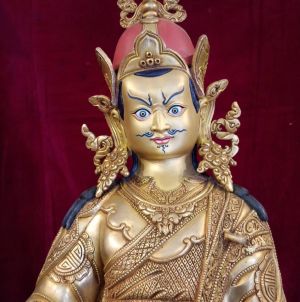Mahayana Uttaratantra Shastra- Vajra Point V: Buddhahood
Vajra Point V: Buddhahood - features eight points: (here are a few general notes)
nature: the nature of buddhahood is defined as the two purities-
These correspond to the two kayas, formless dharmakaya realized during meditation (jnana/yeshe), and the rupakaya 'between sessions' (prajna/sherab) ... as well as... vimuktikaya/dharmakaya or svabhavikakaya/jnana dharmakaya)
In accordance with the gZhantong view, dharmakaya is to be understood as the joint manifestation of the realization of space-like essence (emptiness sTong pa nyid) and the liberated primordial wisdom of awareness (T. rigpa yeshe). Unlike the 'emptiness only' rendering of dharmakaya according to the Rangtong view, this union or coalescence is called dharmakaya (from gZhantong perspective). The form kayas spontaneously arise within this dharmakaya.
cause: the cause of buddhahood is the perfection of tranquility (S. samatha T. zhi-né) and insight (S. vipassana T. lhag tong). all buddhist practices can be divided into either one or both of these, which also correspond to the two accumulations, those of wisdom (non- conceptual virtue) and merit (virtue with concepts). Keep meditating.
fruit: realization of the secret nucleus. this translates as freedom from all emotional and mental defilement, perfect enjoyment of the four mindblows (true purity, spontaneous identification with the essential reality or self, incorruptible happiness, eternal life)
function: overcoming the four primary sufferings (birth, old age, sickness and death) the causes which originally moved Shakyamuni to begin wandering across the plains of northern India, 2500 yrs. ago.
endowments: completely beyond concept and measurement, primordially pure (in itself) and free of all conditional defilement (in the world), empowered with the perfection of wisdoms knowing correctly [profound, suchness) and completely [vast, things in their relations] and transcendent freedoms.
manifestation: in the form of the three kayas, unchanging, unceasing, and undeluded, replete with extraordinary qualities
permanence: of the kayas in the following manner- the permanence and unchanging quality of the absolute nature, the permanence of the perfect enjoyment body is not its unchangingness, but of the unblocked flow of awareness, of the continuity of appearances. Having received teachings and meditated extensively on the all-pervading impermanence of the relative world, the mere notion of permanence should quickly point one in the direction of inconceivability.
inconceivability: first among the 15 endowments, the one that pervades all others. Buddhahood is not attainable by thoughts or conceptual thinking, beyond intellectual modeling or the subtlest of relative designations.
